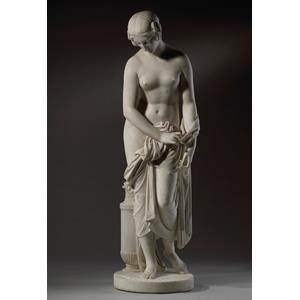DÉTAILS DE L'IMAGE

Gallery Desmet
Richard James Wyatt (London, 1795-1850)
A nymph entering the bath, circa 1830
White marble
H 155 cm
Provenance: private collection
In the annals of neoclassical sculpture, Richard Wyatt's magnum opus, 'Nymph entering the bath,' stands as a monolith of aesthetic and technical excellence. Emerging from an apprenticeship under the great masters of his time - Bosio, Canova, and Thorvaldsen - Wyatt has, with this extraordinary sculpture, left an indelible artistic imprint on an era. After years of mastery as an assistant, Wyatt opened his own studio, acquiring an almost mythical status, not just in his homeland, where his works were eagerly collected by the leading connoisseurs such as the Duke of
Devonshire and even the British Queen, but also in the critical epicenter of the art world: Rome.
It was here that Gerardi lavishly praised the sculpture in 1834 for its 'iconographic innovation' and its 'extremely subtle ability to embody movement, emotion, and inner strength in marble.’ John Gibson RA, the prominent British sculptor, immortalized Wyatt's genius by stating, 'No sculptor in England has produced female figures to be compared with those of Wyatt.’ Owing to the overwhelming success of this sculpture, Wyatt crafted no fewer
than five versions of it, some of which are located in prestigious venues like Wrest Park in Bedfordshire (Earl de Grey's estate) and the Walker Art Gallery in Liverpool (purchased in Rome from the artist in 1838-9 by Mr. & Mrs. Sandbach).
This work serves as the archetype of the English, early 19th-century Grand Tour, an odyssey then undertaken only by the crème de la crème of English society. It is not merely a sculpture, but a monument marking the zenith of neoclassical artistry.



 TÉLÉCHARGER L'IMAGE
TÉLÉCHARGER L'IMAGE